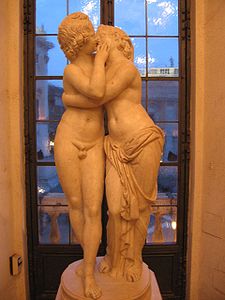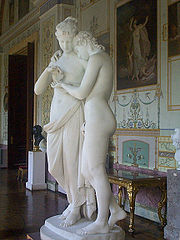
Cupid and Psyche (Roman sculpture)
Encyclopedia

Capitoline Museums
The Capitoline Museums are a group of art and archeological museums in Piazza del Campidoglio, on top of the Capitoline Hill in Rome, Italy. The museums are contained in three palazzi surrounding a central trapezoidal piazza in a plan conceived by Michelangelo Buonarroti in 1536 and executed over...
, Rome
Rome
Rome is the capital of Italy and the country's largest and most populated city and comune, with over 2.7 million residents in . The city is located in the central-western portion of the Italian Peninsula, on the Tiber River within the Lazio region of Italy.Rome's history spans two and a half...
, is a 1st or 2nd century CE Roman copy of a late Hellenistic original. It was given to the nascent Capitoline Museums by Pope Benedict XIV
Pope Benedict XIV
Pope Benedict XIV , born Prospero Lorenzo Lambertini, was Pope from 17 August 1740 to 3 May 1758.-Life:...
in 1749, shortly after its discovery. Its graceful balance and sentimental appearance made it a favourite among the neoclassical
Neoclassicism
Neoclassicism is the name given to Western movements in the decorative and visual arts, literature, theatre, music, and architecture that draw inspiration from the "classical" art and culture of Ancient Greece or Ancient Rome...
generations of artists and visitors, and it was copied in many materials from small bronzes to bisque
Bisque (pottery)
Bisque porcelain is unglazed, white ceramic ware Examples include bisque dolls.Bisque also refers to "pottery that has been fired but not yet glazed...
porcelain. Antonio Canova
Antonio Canova
Antonio Canova was an Italian sculptor from the Republic of Venice who became famous for his marble sculptures that delicately rendered nude flesh...
consciously set out to outdo the Antique original with his own Cupid and Psyche of 1808 (illustration, below left)
The sculpture was discovered in the garden of the vigna of the canonico Panicale on the Aventine Hill
Aventine Hill
The Aventine Hill is one of the seven hills on which ancient Rome was built. It belongs to Ripa, the twelfth rione, or ward, of Rome.-Location and boundaries:The Aventine hill is the southernmost of Rome's seven hills...
in February 1749.
The sculpture quite eclipsed a Roman marble of a winged Cupid and Psyche that had been discovered in the 17th century and removed to the Medici collection
Uffizi
The Uffizi Gallery , is a museum in Florence, Italy. It is one of the oldest and most famous art museums of the Western world.-History:...
in Florence
Florence
Florence is the capital city of the Italian region of Tuscany and of the province of Florence. It is the most populous city in Tuscany, with approximately 370,000 inhabitants, expanding to over 1.5 million in the metropolitan area....
. The Capitoline Cupid and Psyche was among the cream of the Roman collections sequestered by the French under the terms of the treaty of Tolentino
Treaty of Tolentino
The Treaty of Tolentino was signed after nine months of negotiations between France and the Papal States on February 19, 1797. It was part of the events following the invasion of Italy in the early stages of the French Revolutionary Wars...
(1797) and transferred to Paris
Paris
Paris is the capital and largest city in France, situated on the river Seine, in northern France, at the heart of the Île-de-France region...
amid grand theatrics. It was returned to Rome after the fall of Napoleon. Not all viewers were satisfied by its mediocre execution, and Francis Haskell
Francis Haskell
Francis Haskell was an English art historian, whose writings placed emphasis on the social history of art.He read history at King's College, Cambridge and became a Fellow there in 1954...
and Nicholas Penny
Nicholas Penny
Nicholas Penny, FSA is a British art historian. Since Spring 2008 he has been director of the National Gallery in London....
noted that Jean-Baptiste de Saint-Victor thought it was a reflection of some earlier, better work, and that, earlier, Joseph-Jerome Le Français de Lalande hoped in print that it might inspire some modern sculptor to come up with a superior work on the same subject. Antonio Canova took up the challenge quite consciously, in his Cupid and Psyche of 1808.

Giuseppe Fede
Conte Giuseppe Fede was an Italian nobleman, collector and archaeologist of the 18th century. As early as 1724 he started to buy up parcels of land on the site of Hadrian's Villa at Tivoli and excavate on them...
in his early excavations at Hadrian's Villa
Hadrian's Villa
The Hadrian's Villa is a large Roman archaeological complex at Tivoli, Italy.- History :The villa was constructed at Tibur as a retreat from Rome for Roman Emperor Hadrian during the second and third decades of the 2nd century AD...
, Tivoli
Tivoli, Italy
Tivoli , the classical Tibur, is an ancient Italian town in Lazio, about 30 km east-north-east of Rome, at the falls of the Aniene river where it issues from the Sabine hills...
. It has disappeared now, but it was drawn, in its completed and restored condition, by Pompeo Batoni
Pompeo Batoni
Pompeo Girolamo Batoni was an Italian painter whose style incorporated elements of the French Rococo, Bolognese classicism, and nascent Neoclassicism.-Biography:He was born in Lucca, the son of a goldsmith, Paolino Batoni...
, who was assembling a "paper museum" of antiquities in 1727-30 for the English antiquary Richard Topham. As it was restored, Cupid turns his head away coyly.

